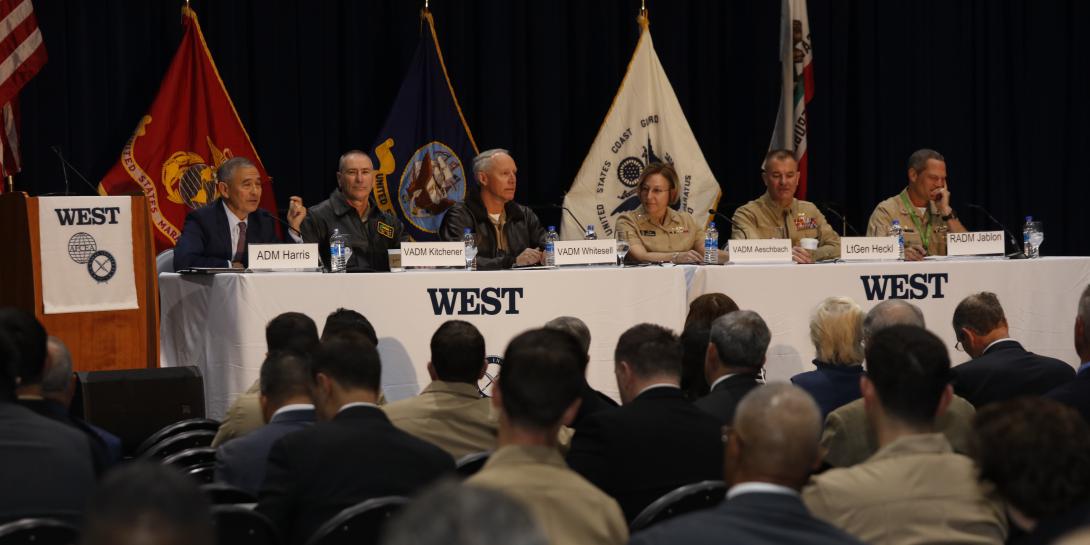Naval Forces Could Adapt Faster to Compete with China
U.S. military officials in the Indo-Pacific region agree that to compete with China, U.S. naval forces should adapt more quickly.
Asked specifically by an audience member at WEST 2022, the conference and exposition hosted by AFCEA International and the U.S. Naval Institute in San Diego February 16-18, whether the military is adapting quickly enough for China, multiple members of a panel agreed that the answer is “no.”
Focusing primarily on training, Vice Adm. Kelly Aeschbach, USN, commander, Naval Information Forces, said the United States is not yet providing the necessary complexity in its training.
“I would say that I worry that we’re not adapting fast enough, and part of that is on us because … we’re not providing deep enough, complex enough training to really challenge our folks on their skills and skill development,” she said. “I think we have the talent. We’re recruiting fabulous people but whether we’re arming them to actually understand the complexity and affording them the chance to be really innovative with the capabilities we’ve given them, I do worry that we’re not moving fast enough.”
We’re recruiting fabulous people but whether we’re arming them to understand the complexity and affording them the chance to be innovative with the capabilities we’ve given them, I worry that we’re not moving fast enough.-VADM Kelly Aeschbach, cdr, Naval Info Forces
— George Seffers (pronounced See furs) (@gseffers) February 16, 2022
WEST2022
She noted that the Navy is making progress and specifically cited work being done at the warfighter development centers and strike groups 4 and 15. “I would give great credit right now to Strike Group 4 and Strike Group 15 for the cooperative work they’ve been doing and really developing more complex scenarios and events that I think are creating the kind of stressing environments that are forcing, across all of our mission areas, the integration that really is, hopefully, testing us in ways that we may have to operate down the line.”
But the pace of change is a concern for all, she concluded. “We recognize, and I think we all are stressed that we may not be doing enough or moving fast enough and are all in lock step trying to move as fast as we can and do better.”
Lt. Gen. Karsten Heckl, USMC, commander, Marine Corps Combat Development, agreed the pace of change is too slow. “If anybody thinks we’re moving fast enough, you’re crazy. It’s insanity. I would say we need to double down our efforts and figure out a way to move quicker,” he declared. “Does that mean there’s going to be risk? Yes. But consider the option.”
Lt. Gen. Karsten Heckl, USMC, commander, Marine Corps Combat Development, on whether U.S. is adapting fast enough to compete with China:
— George Seffers (pronounced See furs) (@gseffers) February 16, 2022
If anybody thinks we’re moving fast enough, you’re crazy. It’s insanity. Does that mean there's going to be risk? Yes.#WEST2022
The Marine Corps also is making significant strides under the commandant’s leadership, he added. “We’re moving. We’re moving fast. Some would say too fast. I disagree. I think we’re moving about the right speed, and we’ll modulate,” he asserted. “But the point is, let’s start doing some OJT [on-the-job training]. Let’s get some stuff out in the field. Let’s get some stuff in the hands of the operators and then we go from there.”
Rear Adm. Jeffrey Jablon, USN, commander, Submarine Force, U.S. Pacific Fleet, pointed out that technology development for submarines sometimes aims 10 years into the future. “We are not moving fast enough. I need technologies in the near term. I need [tactical development] to be done quickly and put those technologies on my submarines for the near term, the next two to five years.”
While progress may still be too slow, the pace is picking up, according to Vice Adm. Roy Kitchener, USN, commander, Naval Surface Forces and Naval Surface Force, U.S. Pacific Fleet. “I would say we’re not moving fast enough, but our velocity is increasing. I would tell you the amount of integrated training that we do with the aviation community and the submarine community … is at a level I’ve never seen before,” he reported. “That’s a good sign.”





Comments